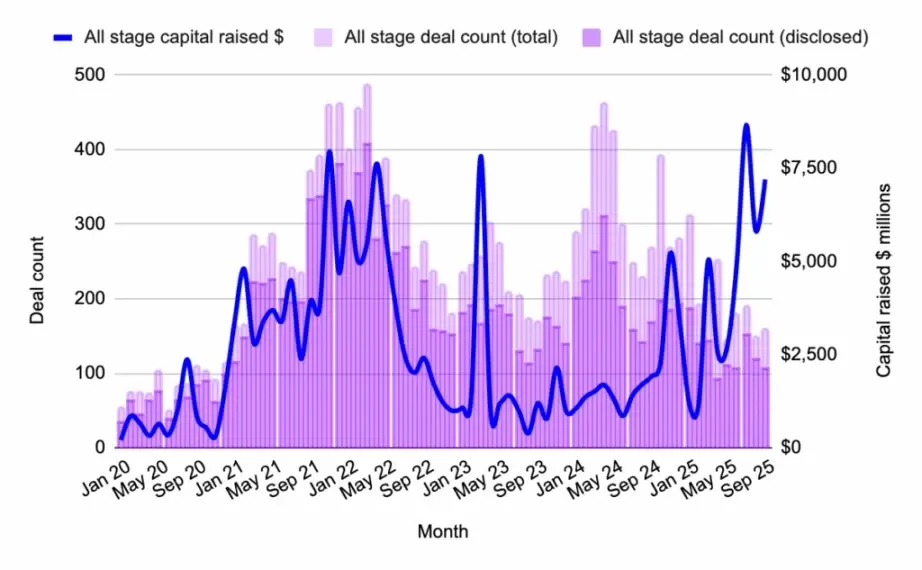Author: likong
On October 29, 2025, Nvidia became the first company in human history to surpass a market value of $5 trillion. On the same day, a Dutch auction for a cryptocurrency project just concluded, opening below its initial price, with participants suffering an average loss of 10%.
This is the most accurate portrayal of 2025. On one side, Nvidia surged from $4 trillion to $5 trillion in just three months, surpassing the total market value of all cryptocurrencies globally; on the other side, the entire cryptocurrency industry is in disarray, with Bitcoin at $120,000 being the only highlight, while altcoins have fallen below levels seen after the FTX collapse three years ago, and trading volume has plummeted by 32% year-on-year.
A friend recently said, "This year, trading cryptocurrencies has yielded returns that are completely inferior to my mom trading A-shares." It sounds like a joke, but this is the stark reality of the cryptocurrency space in 2025. When over 440 A-shares have doubled in the first three quarters, the average first-day gain for new listings in Hong Kong is 38%, gold has risen over 50%, and meme stocks in the U.S. have doubled, people in the cryptocurrency space are left battered and bruised.
The Whole World is Rising
2025 is a rare "auspicious year." Almost all capital markets are on the rise.
A-shares are experiencing a once-in-a-decade rally. The stock of Weit New Materials on the Sci-Tech Innovation Board surged 1278% from July 9 to October 24 due to its association with AI concepts, becoming the first 10x stock in A-shares for 2025. In just 16 trading days, Weit New Materials recorded 11 instances of 20% daily limits, with its market value skyrocketing from 3 billion to 37.1 billion. Such wealth creation speed is extremely rare in the history of A-shares.
The performance of Hong Kong stocks is equally impressive. The Hang Seng Index has risen nearly 29% this year, Alibaba's stock price has doubled, and Tencent has increased by over 50%.
Even more enviable is the Hong Kong IPO market. As of July, 52 companies have gone public in Hong Kong in 2025, with a first-day loss rate of only 23% and an average first-day gain of about 38%. Yingen Biotechnology saw a first-day increase of 116.7%, Yisou Technology rose 91.72% on its debut, and Maoge Ping and Laopu Gold increased by 76.51% and 72.84%, respectively. Some say, "This year, making money from IPOs is equivalent to what others earn from trading for half a year," which is not an exaggeration.
The rise in gold prices is even more astonishing. The international gold price rose from $2,590 at the beginning of the year to $4,100 by the end of October, an increase of over 50%. This could become the year with the largest increase in gold prices since 1979. The S&P Global Gold Mining Index soared by 129%, and Zijin Mining's market value surpassed 1 trillion.
As for U.S. stocks, Nvidia, Microsoft, and Meta have all reached historical highs. Even meme stocks are allowing retail investors to profit. OpenDoor surged 2000% in three months, and Beyond Meat rose 1100% in just a few days. These companies, once abandoned by Wall Street, have been revitalized by retail investors' enthusiasm.
And what about the cryptocurrency space?
Bitcoin did indeed reach a historic high of $120,000, but this number is meaningless to most people. Altcoins have fallen below levels seen after the FTX collapse, new projects open below their initial prices, and yield farming studios have switched to IPOs in Hong Kong. In Q3 2025, trading volume declined by 32% year-on-year.
Is Blockchain Still a Tech Industry?
AI is the global theme, with Nvidia, valued at $5 trillion, leading the way. This figure exceeds the total value of the global cryptocurrency market, surpasses the combined market values of the stock markets in the UK, France, and Germany, and approaches the total value of the Indian stock market.
Behind this number lies a real technological barrier and commercial value. The training of large models globally relies on Nvidia's chips, with OpenAI, Google, and Meta as its clients. Autonomous driving, robotics, and AI applications all require computational power support at every stage. This is tangible income and real profits. In Q3 2025, Nvidia's revenue reached $35 billion, a 94% year-on-year increase, with a net profit margin exceeding 50%.
And what about the cryptocurrency space? The cryptocurrency sector has dabbled in AI, but it has only scratched the surface, with the so-called blockchain + AI, yet no application has truly demonstrated "this is impressive." The AI tools used in the industry have little to do with blockchain. Not to mention those fake projects that issue tokens under the guise of AI.
There are even established processes, such as determining how much to raise in valuation, finding who can list on which platform, identifying who can lead a round of KOLs, and finally deciding where to exit and end the next cycle.
The blockchain industry should be a tech industry, with Bitcoin as the leader of the tech sector, but it is now completely devoid of any technological essence, reduced to mere finance.
Looking back, every bull market has been driven by clear technological breakthroughs.
In 2017, the explosion of ICOs and smart contract platforms. Ethereum proved that blockchain is not just about currency but can also support applications. Although most ICO projects ultimately went to zero, this wave did indeed promote the development of public chain infrastructure. Vitalik Buterin's concept of smart contracts opened up possibilities for countless developers in the blockchain space.
From 2020 to 2021, the dual explosion of DeFi and NFTs. Uniswap redefined trading platforms with its automated market-making mechanism, Aave and Compound decentralized lending, and Curve optimized stablecoin trading. The total value locked in these protocols once exceeded $200 billion. NFTs provided a new form of digital ownership expression, from artworks to game items, from domain names to identity verification. Both of these tracks are native innovations of the cryptocurrency space, addressing real problems.
In 2024, the market began to tell stories about AI, and we could still attempt some AI infrastructure, but only for a year.
In 2025, we began to accumulate points.
Of course, there are many objective reasons that have led to the apparent lack of liquidity, but the essence is still a lack of innovation and inflated market values.
From token financing to DeFi, the cryptocurrency space took three years. From DeFi to now, another four years have passed. Yet in these four years, the cryptocurrency space has not seen any native innovation that can match DeFi.
While traditional capital markets find new growth logic in AI, energy, and manufacturing, blockchain remains trapped in a self-referential context. Nvidia is developing the next generation of chips, Tesla is advancing autonomous driving, and OpenAI is training more powerful models. Meanwhile, blockchain is just accumulating points.
This is the greatest sadness of blockchain in 2025.
免责声明:本文章仅代表作者个人观点,不代表本平台的立场和观点。本文章仅供信息分享,不构成对任何人的任何投资建议。用户与作者之间的任何争议,与本平台无关。如网页中刊载的文章或图片涉及侵权,请提供相关的权利证明和身份证明发送邮件到support@aicoin.com,本平台相关工作人员将会进行核查。




